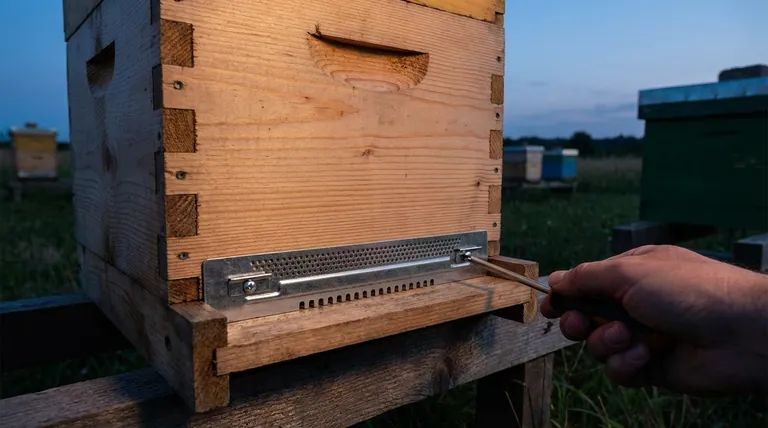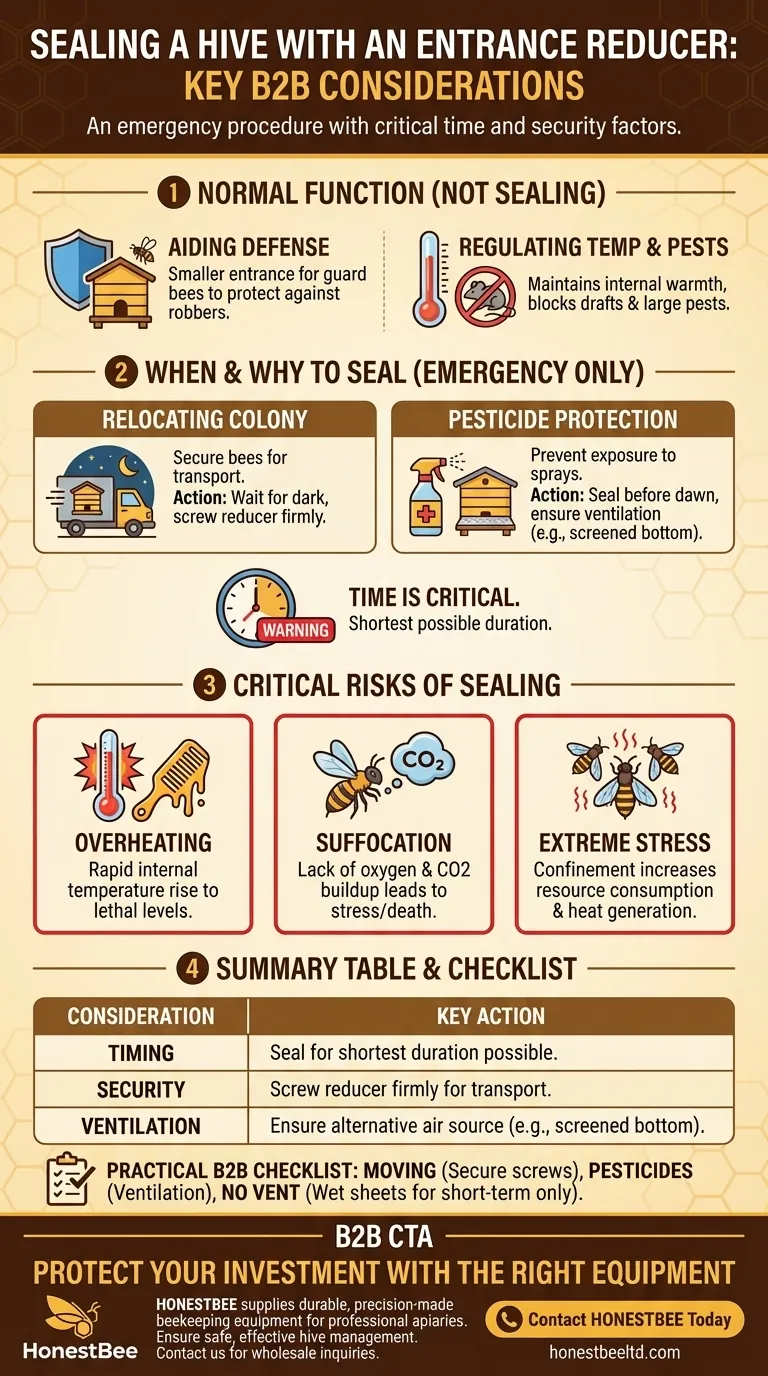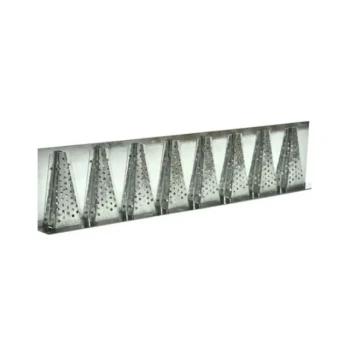When sealing a hive with an entrance reducer, your two most critical considerations are time and security. This action should only be performed for the shortest possible duration to prevent the colony from overheating, and if moving the hive, the reducer must be screwed firmly into place to prevent it from coming loose during transit.
Sealing a hive is an emergency procedure, not a routine practice. The central challenge is managing the immense metabolic heat a trapped colony generates; without proper ventilation and a strict time limit, you risk cooking your bees.

The Primary Purpose of an Entrance Reducer
Before discussing sealing, it's vital to understand an entrance reducer's normal function. Its primary job is not to seal the hive but to manage the size of the entrance.
Aiding in Hive Defense
For new or smaller colonies, a large entrance is an open invitation to robber bees from stronger hives. Reducing the entrance size creates a smaller, more defensible chokepoint, allowing the guard bees to effectively protect their resources.
Regulating Temperature and Airflow
In colder climates, a smaller entrance helps the colony maintain its internal cluster temperature more efficiently. It reduces drafts and limits the volume of cold air entering the hive, conserving the bees' energy and food stores.
Managing Pests
Pests like yellow jackets and mice can be a significant threat. A reduced entrance is too small for mice to enter, and it helps the bees defend against invading wasps.
When to Completely Seal a Hive
Completely blocking the entrance is a high-stakes maneuver reserved for specific, temporary situations.
Relocating a Colony
The most common reason to seal a hive is for transportation. Sealing ensures the bees remain safely inside the hive while it is being moved to a new location. This is typically done at night when all the foragers have returned.
Protecting from External Threats
If nearby fields are being sprayed with pesticides, you may need to seal the hive to protect the colony from exposure. This is a time-sensitive operation that requires careful management to prevent colony loss from overheating.
Critical Risks of Sealing a Hive
Locking tens of thousands of insects in a box is inherently dangerous. Understanding these risks is key to preventing disaster.
Overheating and Suffocation
A healthy colony generates a tremendous amount of heat. Without the ventilation provided by an open entrance, the internal temperature can rise to lethal levels in a surprisingly short amount of time, literally cooking the bees and melting the comb.
Lack of Air Exchange
Bees, like all living organisms, require oxygen. Sealing the hive completely cuts off fresh air, leading to a rapid buildup of carbon dioxide. This stresses the colony and can lead to suffocation if the hive is sealed for too long.
Extreme Colony Stress
Confinement is unnatural and highly stressful for bees. A sealed colony will become extremely agitated, consuming more resources and generating even more heat, which exacerbates the risk of overheating.
A Practical Checklist for Sealing Your Hive
Your approach depends entirely on your goal. Follow the checklist that matches your situation.
- If you are moving the hive: Wait until dark, after all foragers are home. Turn the reducer to the fully closed position and secure it with screws to ensure it cannot vibrate loose during the move.
- If you are protecting from pesticides: Seal the hive just before dawn, before the foragers leave. Ensure the colony has adequate ventilation through a screened bottom board or top vent, and reopen the hive as soon as the danger has passed.
- If your hive lacks integrated ventilation: Sealing for more than a couple of hours is extremely risky. Consider draping wet sheets over the hive during the sealed period to help with evaporative cooling.
Ultimately, your role is to intervene only when necessary and to minimize the stress on the colony at all times.
Summary Table:
| Consideration | Key Action | Purpose & Risk |
|---|---|---|
| Timing | Seal for the shortest duration possible. | Prevents lethal overheating and suffocation. |
| Security | Screw the reducer firmly in place for transport. | Ensures the entrance stays sealed during transit. |
| Ventilation | Ensure an alternative air source (e.g., screened bottom). | Mitigates risk of CO2 buildup when sealed for protection. |
Protect Your Investment with the Right Equipment
Sealing a hive is a high-stakes procedure that requires reliable, secure equipment to succeed. For commercial apiaries and distributors, using poorly designed entrance reducers can lead to catastrophic colony loss.
HONESTBEE supplies durable, precision-made beekeeping supplies and equipment built for the demands of professional beekeeping. Our entrance reducers are designed for a secure fit, helping you manage hive entrances effectively and safely.
Ensure your hive management is safe and effective. Contact HONESTBEE today to explore our wholesale-focused catalog and get the reliable equipment your operation depends on.
Visual Guide

Related Products
- Beehive Entrance Reducer Guardian Metal Hive Entrance for Bees
- Steel Round Disc Entrance Reducer for Flexzion Bee Hive Nuc Box Gate
- Multi-Functional Sliding Hive Entrance for Beekeeping
- Multi-Functional Rotary Hive Entrance Disc for Beekeeping
- Professional Reversible Beehive Hive Entrance
People Also Ask
- What happens if you seal an entrance to a bee hive? Avoid a Costly Structural Disaster
- What are the features of the side with oblong holes in the entrance reducer? A Guide to Hive Defense & Health
- What size is the entrance hole in a native bee hive? The 13mm Standard for a Thriving Colony
- What is the purpose of placing an object in front of the hive entrance after a move? A Guide to Forced Reorientation
- What are the different types of entrance reducers available? A Guide to Protecting Your Hive



















